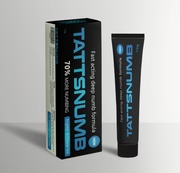In the intricate tapestry of medical and cosmetic procedures, the pursuit of comfort amid occasionally uncomfortable processes has propelled the prevalence of numbing creams. These topical anaesthetics, often containing active ingredients like lidocaine, prilocaine, or benzocaine, have revolutionised the way we experience certain treatments, rendering them more tolerable and less daunting. This article embarks on a journey through the world of numbing creams, unravelling the intricacies of their composition, the array of benefits they offer, and the versatile applications that make them indispensable across various fields.
What Is Numbing Cream?
Numbing cream, also recognized as a topical anaesthetic, is a specialised formulation crafted to temporarily desensitise the skin. The fundamental principle underlying their efficacy lies in the inclusion of active ingredients that impede nerve signals in the treated area, resulting in a reduction of sensations such as pain. If you’re looking to buy numbing cream, this temporary numbing effect plays a pivotal role in numerous medical and aesthetic procedures, ensuring that patients can navigate discomfort with greater ease.
These creams often feature lidocaine, prilocaine, or benzocaine as their active components, each with its unique mechanism of action. Lidocaine, for instance, blocks sodium channels, hindering nerve signal transmission. Prilocaine, another commonly used agent, operates similarly by obstructing nerve signals. Benzocaine, on the other hand, works by inhibiting the sensation of pain through its numbing properties. Understanding the composition and mechanism of action of numbing creams is crucial in appreciating their multifaceted benefits and widespread applications, especially if you’re considering where to buy numbing cream for your specific needs.
Numbing Cream Benefits
Here are the following numbing cream benefits:
- Pain Relief: The primary and most evident benefit of numbing creams is their exceptional ability to provide pain relief. Whether undergoing a minor surgical procedure, receiving a tattoo, or enduring laser hair removal, the application of numbing cream significantly alleviates discomfort, making the overall experience more bearable.
- Reduced Anxiety: Knowing that a procedure might involve some level of pain can trigger anxiety in many individuals. Numbing creams play a crucial role in mitigating this anxiety by providing a sense of control over the pain factor. This not only benefits the patient’s mental well-being but also contributes to a smoother procedure.
- Enhanced Patient Experience: Medical and cosmetic professionals prioritise patient comfort for good reason. The use of numbing creams contributes to an enhanced overall experience for patients, fostering a positive perception of the procedure and the practitioner. This, in turn, can lead to increased patient satisfaction and loyalty.
- Facilitation of Precision Procedures: Numbing creams facilitate precision in various procedures by ensuring the patient remains still and relaxed. This is particularly crucial in dermatological and cosmetic treatments where even the slightest movement can impact the outcome. The numbing effect allows practitioners to carry out intricate procedures with greater accuracy.
- Extended Treatment Durations: Some systems, such as laser treatments or tattoo sessions, require a significant amount of time. Numbing creams enable longer treatment durations by minimising discomfort, allowing both the practitioner and the patient to focus on achieving optimal results without the hindrance of pain-related interruptions.
Uses Of Numbing Cream
Here are the uses of numbing cream:
- Dermatological Procedures: Numbing creams find extensive use in dermatology for various procedures such as mole removal, skin biopsies, and laser treatments. These creams ensure that patients can undergo these treatments without unnecessary discomfort.
- Tattooing and Body Piercing: The world of body art has embraced numbing creams to make tattooing and Body piercing more tolerable. Both artists and clients benefit from reduced pain, allowing for a smoother and more enjoyable session.
- Cosmetic Injections: Procedures like Botox and dermal fillers involve injections, which can be painful. Numbing creams are applied beforehand to ease the discomfort associated with needle penetration, making these cosmetic treatments more pleasant.
- Hair Removal: Waxing and certain hair removal treatments can be quite painful. Numbing creams are commonly used in these scenarios to minimise the pain associated with hair removal, providing a more comfortable experience for clients.
- Minor Surgical Procedures: In minor surgical interventions, where local anaesthesia is suitable, numbing creams are employed to ensure that patients experience minimal pain during procedures like suturing of wound care.
Conclusion
Numbing creams have emerged as valuable allies in various medical and cosmetic fields, transforming the way we perceive and undergo different procedures. Their ability to provide effective pain relief, reduce anxiety, and enhance the overall patient experience makes them indispensable in the toolkit of healthcare professionals and practitioners alike. As technology continues to advance, the applications of numbing creams will likely expand, offering comfort and convenience in realms we might not even envision today. As we navigate the ever-evolving landscape of healthcare and aesthetics, numbing creams stand as a testament to our commitment to making the journey to wellness and self-enhancement as painless as possible.
